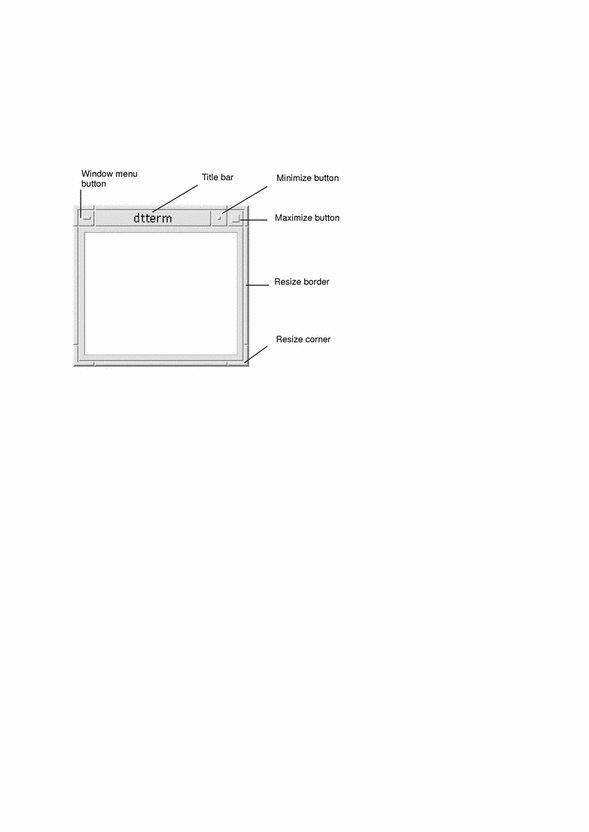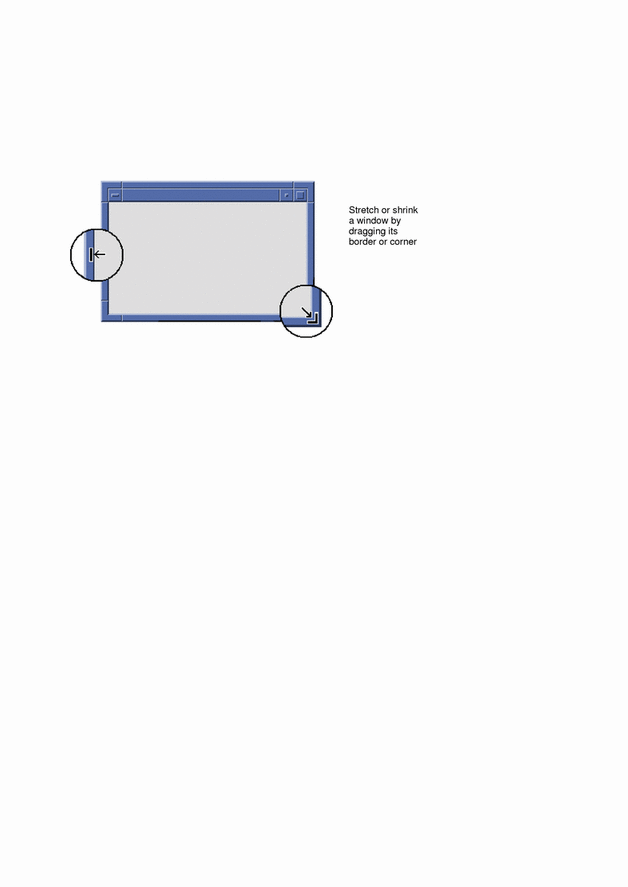Working with Windows
This section describes how to open, close, and manipulate windows in a workspace.
Window Frame Controls
A window's frame provides controls with which you can:
-
Focus attention on a window, making it active (indicated by its frame changing color) for input from your mouse or keyboard
-
Move a window
-
Minimize a window into an icon
-
Size a window
-
Close a window, removing it from the desktop
-
Display a window in other workspaces
Refer to Chapter 7, Customizing the Desktop Environment for information about settings that make windows active.
Figure 1-4 Window Frame Controls

Click the Window menu button to display the Window menu.
To close a window and remove it from the desktop, double-click the Window menu button or display the Window menu and choose Close.
Click the minimize button to turn the window into a window icon. To restore a window from its icon, double-click the icon.
Click the maximize button to display the window in its largest allowable size. Return the window to its former size by clicking the maximize button again.
The title bar shows the name of the application that owns the window. Select a window by clicking its title bar. You can move a window by dragging its title bar.
Drag a window's resize corner or border to resize the window.
For information on keyboard navigation and windows, see "Opening and Closing Windows" in Appendix A, Keyboard Shortcuts for the Desktop.
To Open an Application Window
Mouse
Click the application's control in the Front Panel.
Or, from within Application Manager, double-click the application's icon.
Or, from within File Manager, choose an action for a selected icon from the Selected menu.
Or, from the Workspace Programs submenu, choose the item with the application name.
You can also select an icon in a File Manager or Application Manager window by clicking it and then choose an action for the selected icon from the Selected menu.
Keyboard
From the Front Panel:
-
Press Alt+Tab to move the keyboard focus to the Front Panel.
-
Press the arrow keys to move the highlight within the Front Panel and select a control.
-
Press Spacebar or Return to choose the control and open the application's window.
From Application Manager:
-
Open the Application Manager window by choosing its Front Panel control as described above.
-
Press the arrow keys to move the highlight to an application group icon within the Application Manager window.
-
Press Return twice to open the application group.
-
Press the arrow keys to move the highlight to an application or action icon, then press Return twice to start the application.
To Close an Application Window
Closing an application window removes it from all workspaces. Closing an application is the same as quitting an application on other systems.
Before closing an application window, save your work. In most applications you can do this by choosing Save from the File menu.
Mouse
Choose Close from the application's File menu.
Or, double-click the Window menu button (in the upper left corner of the application's window).
Keyboard
To Turn a Window into an Icon
To save screen space, you can minimize windows into window icons. This keeps the windows easily available and programs running in them continue to run.
Mouse
Click the window's minimize button.

Keyboard
-
Press Down Arrow until you select Minimize, then press Return.
-
Or, press N, the menu's mnemonic for Minimize.
To Restore a Window from an Icon
Mouse
Keyboard
-
With keyboard focus on the icon, press Alt+Spacebar to display the Window menu.
-
Press Down Arrow to select Restore, then press Return.
To Move a Window or Window Icon
Mouse
Keyboard
-
Press Alt+Spacebar to display the Window menu.
-
Press M, the menu's mnemonic for Move.
-
Press the arrow keys to relocate the window or icon.
Hold down Control while you press an arrow key to speed up the movement of the window or icon.
-
When you've moved the window or icon to where you want it, press Return.
To cancel the move operation, press Esc.
To Resize a Window
Mouse
-
Place the pointer on a window's border or corner.
The pointer changes to a resize arrow.
-
Drag the border or corner. An outline appears to show you the window's new size.
-
Release the mouse button when the outline shows the window's desired size.

Keyboard
-
Press Alt+Spacebar to display the Window menu.
-
Press S, the menu's mnemonic for Size.
-
Press the arrow keys to stretch or shrink the window.
Hold down Control while you press an arrow key to size the window faster.
-
When the outline shows the size you want, press Return.
To cancel the resize operation, press Esc.
To Bring a Window or Icon Forward
Mouse
Click a visible part of the window's frame or anywhere on the icon.
Keyboard
-
To bring the bottom window or icon in a workspace forward, press Alt+Up Arrow.
-
To place the top window in the background, press Alt+Down Arrow.
-
To cycle through and select the windows and icons in a workspace, press Alt+Tab or Alt+Esc.
-
To cycle through and select the windows and icons in reverse order, press Shift+Alt+Tab or Shift+Alt+Esc.
To Copy and Paste Text into Windows
Copying and pasting eliminates the need to retype text.
You can copy from and paste text into:
-
Text fields
-
Terminal emulator windows
-
Text Editor windows
-
Mailer Compose windows
You can also copy text from a Mailer message view and a Help Viewer window and paste it into Text Editor, terminal emulator, and Mailer Compose windows.
Selecting the Text To Be Copied
-
Move the pointer to the start of the text to be pasted.
-
Drag to the end of the text to be pasted, then release the mouse button, leaving the text highlighted.
Pasting Text
- © 2010, Oracle Corporation and/or its affiliates
